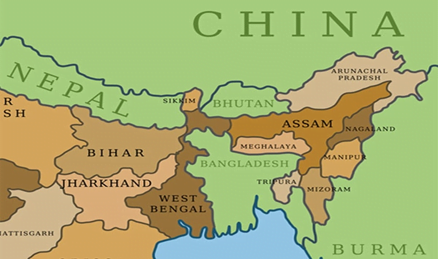International Relations
Context: Following a meeting with the visiting Prime Minister of Bangladesh Sheikh Hasina, Prime Minister of India said India and Bangladesh will resolve all issues and problems on shared consensus.
India-Bangladesh relations in depth:
Historic relations:
- India was the chief architect of Bangladeshi independence from the oppressive political rule of (west) Pakistan in 1971.
- In December 1971, the chief of the Pakistani forces had surrendered unconditionally to the allied forces consisting of Indian Army and Mukti Bahini in Dhaka. It was a guerrilla resistance movement.
- India was one of the first countries to recognize Bangladesh and establish diplomatic relations immediately after its independence in December 1971.
Economic Relations:
- In 2021-22, Bangladesh has emerged as the largest trade partner for India in South Asia and the fourth largest destination for Indian exports
- India’s main exports to Bangladesh are raw cotton, non-retail pure cotton yarn, and electricity and main imports includes pure vegetable oils, non-knit men’s suits, and textile scraps.
- Both countries may sign a Comprehensive Economic Partnership Agreement (CEPA) during the visit. It covers negotiation on the trade in services and investment, and other areas of economic partnership.
Defence Cooperation:
- Border Management: India and Bangladesh share longest land boundary that India shares with any of its neighbours.
- In 2015, India and Bangladesh resolved the decades-long border dispute through the Land Swap Agreement (exchange of enclaves). (100th CAA, 2015)
- Various Joint exercises of Army (Exercise Sampriti) and Navy (Exercise Milan) take place between the two countries.

Current Institutional Frameworks:
- Under the provisions of the South Asian Free Trade Area (SAFTA), Bangladesh extends preferential tariffs to Indian exports of products outside the ‘sensitive list’ of 993 items.
- The MoU on Border Haats on the India-Bangladesh border was renewed in April 2017. Currently, four Border Haats — two each in Meghalaya (Kalaichar and Balat) and Tripura (Srinagar and Kamalasagar) — are functional.
- Members of major regional organisations like South Asian Association for Regional Cooperation (SAARC) and the Bay of Bengal Initiative for Multi-Sectoral Technical and Economic Cooperation (BIMSTEC)
Medical tourism:
- Bangladesh accounts for more than 35% of India’s international medical patients.
- Bangladesh alone contributes to more than 50% of India’s revenue from medical tourism
Connectivity:
- Both countries jointly inaugurated the newly restored railway link between Haldibari (India) and Chilahati (Bangladesh).
- Agreed to an early operationalization of the Bangladesh-Bhutan-India-Nepal (BBIN) initiative Motor Vehicles Agreement through the expeditious signing of the Enabling MoU.
- The Protocol on Inland Waterways Trade and Transit (PIWTT) allows the movement of goods by barges/ vessels on eight routes between points in India and Bangladesh.
Challenges
In 2019, India enacted the National Register of Citizens and the Citizenship (Amendment) Act (CAA, 2019), which created an uproar within and beyond the borders. Ms. Hasina termed the move as “unnecessary”. It had ripple effects for Bangladesh.
The Teesta River water dispute:
- The sharing of the waters of the Teesta has remained a thorny issue since 1947 although a bilateral Joint Rivers Commission (JRC) has been working since June 1972.
- The 2011 interim deal aims to share the Teesta River water between India and Bangladesh about 42.5 per cent and 37.5 per cent respectively. But, the state of West Bengal object to this demand and never signed the deal, and strain in this issue goes on.
Rohingya issue: Bangladesh also requires China’s support in resolving the Rohingya refugee crisis. India has refused providing asylum to Rohingyas but is helping Bangladesh settle them in its char islands.
Regional geopolitics:
- China has been actively pursuing bilateral ties with Bangladesh. Bangladesh had successfully approached China for a mega project to enhance Teesta River water flow.
- Bangladesh is the second biggest arms market for China after Pakistan.
- Bangladesh is an active partner of the Belt and Road Initiative (BRI) that India has not signed up to.
Way forward:
- The early resolution of river water disputes like Teesta is the better way to boost India-Bangladesh relations.
- Involvement of joint forces to reduce border issues such as illegal trading, trafficking, cattle smuggling, etc
- Strengthening of regional groups like SAARC, BIMSTEC etc and focusing on Neighbourhood First policy.
Just as Bangladeshis remain grateful to India for the generous support extended by India during the Liberation War of 1971, they are equally sensitive to being treated with respect and fairness, no matter who rules their country.
Source: The Hindu















